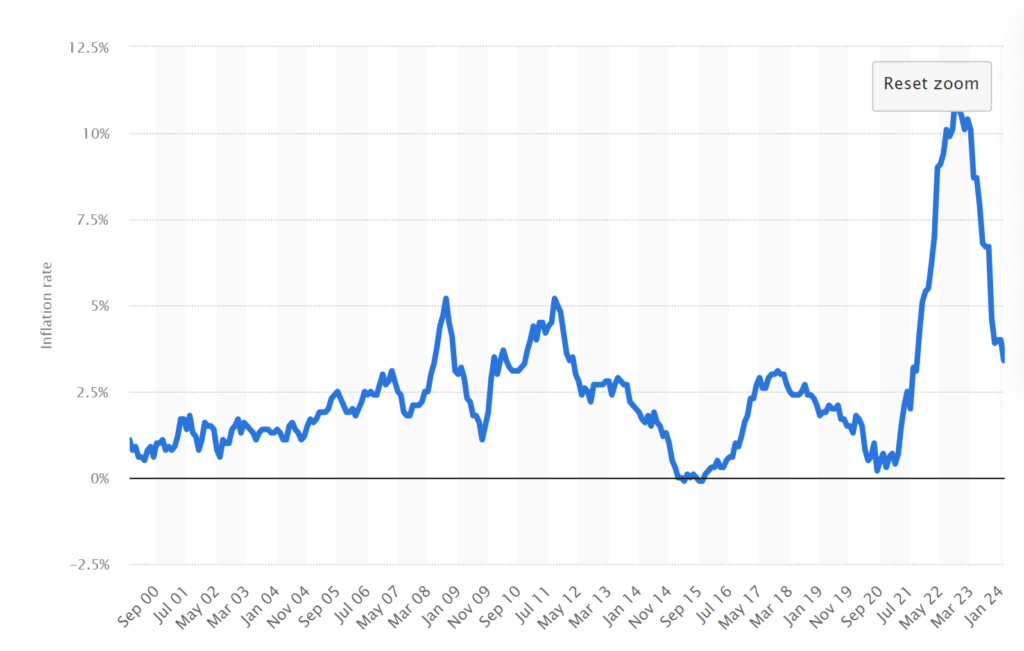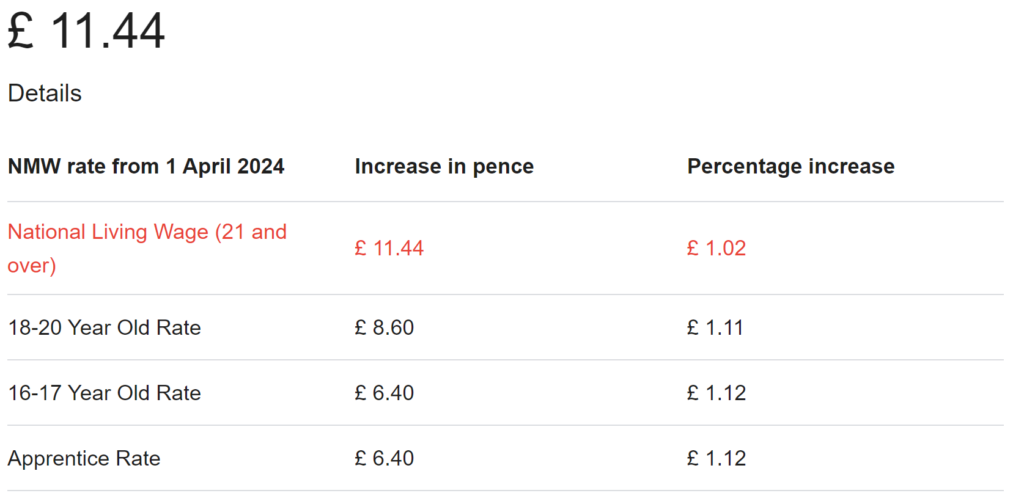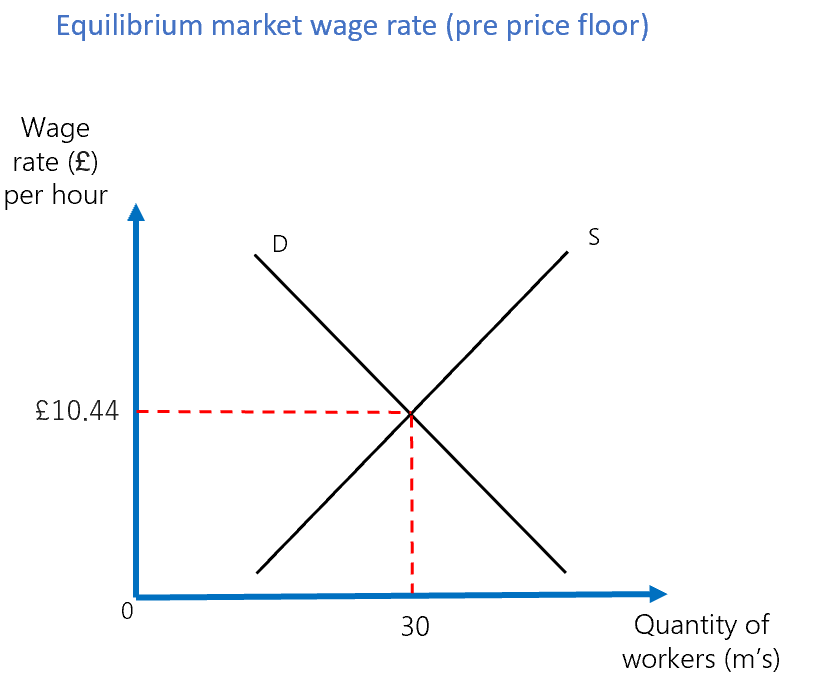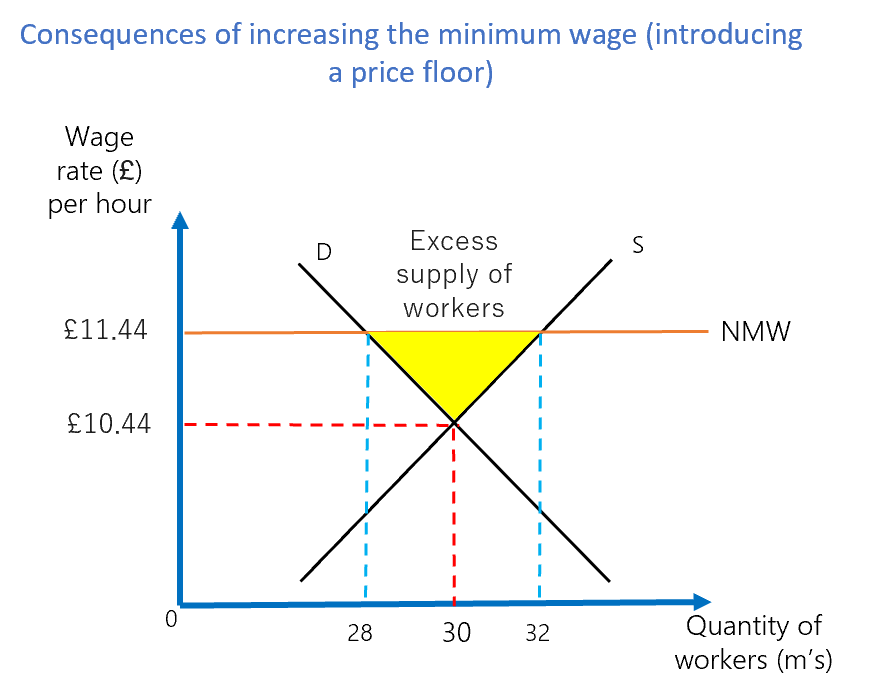IB Economics
IB Economics real world examples RWE's
Price Floors
Price floors in the real world
A price floor is a minimum price set by the government for a particular good or service, above the equilibrium price.
In this case, we look at minimum wages as an example of a price floor. The UK sets a legally binding minimum wage to protect workers against unduly low wages. This is especially important in times of rising prices, like the UK has experienced recently (see blue line graph to the right showing: Inflation rate for the Consumer Price Index (CPI) in the United Kingdom from January 1989 to February 2024)
Minimum wages are constantly revised to make sure they offer adequate remuneration (pay) per period time for workers. This policy aims to reduce poverty and income inequality, encouraging fair pay for work done. A minimum wage is even more relevant considering the recent cost of living crisis in mind! Because of this recent inflation spike, low income, fixed income and retirees suffered a disproportionate hit to their purchasing power and ability to buy goods and services.
For this reason, the UK government revised the legally binding minimum wage upwards to £11.44 per hour (see wages table to the right).
Whilst an increase in minimum wage is always celebrated by workers, it is rarely celebrated by businesses and usually agreed to be destructive to overall employment!
Here is why.
For workers: the increase in minimum wage increases affordability of goods and services. This is a positive outcome as wages increase by £1/hour (before tax)
For businesses: don’t forget that the demand curve represents, ‘demand for labour’! Referring to the diagram, as the NMW increases (price floor) demand for labour falls from 30 million workers to 28 million workers, creating a yellow section of excess supply of labour!
The market: Increase in NMW reduces demand for labour, causing unemployment (from 30m workers at equilibrium to 28m after the new NMW is implemented), which is destructive as one of the major objectives of government.
Black market: As business costs increase with rising NMW’s, there is an incentive for businesses to hire workers illegally and pay them in cash or ‘under the table’. This incentive is more likely as the supply of undocumented labour rises in the UK, which is currently estimated to be between 0.5 and 1m people in 2024.
The conclusion is that, whilst those who retain their jobs receive a pay rise, but the net result is greater joblessness! The effectiveness of a price floor in this case needs some serious discussion to address the unintended consequences that follow!

UK Inflation from 2000 to 2024


Equilibrium employment in the UK (prior to the new NMW being implemented)

The effect of a price floor, NMW






Do I really need real world examples RWE's for IB Economics?
Price floors are government-imposed minimum prices set above the equilibrium price to ensure fair compensation for producers or workers. While they aim to protect these groups, price floors can lead to unintended economic consequences. Understanding their impact through real-world examples is essential for a comprehensive grasp of IB Economics.
Agricultural Price Supports: The European Union’s Common Agricultural Policy (CAP)
The European Union’s CAP implements price floors for various agricultural products to stabilize farmers’ incomes and ensure food security. By setting minimum prices, the EU guarantees that farmers receive adequate compensation, even when market prices fall. However, this intervention often leads to overproduction, resulting in surplus commodities. To manage these surpluses, the EU has historically resorted to intervention storage, commonly known as “butter mountains” and “wine lakes,” where excess produce is stored to prevent market prices from collapsing. While these measures support farmers, they also lead to significant storage costs and market distortions.
Minimum Alcohol Pricing: Scotland’s Public Health Initiative
In 2018, Scotland introduced a minimum unit pricing (MUP) for alcohol, setting a price floor of 50 pence per unit. This policy aimed to reduce excessive alcohol consumption by increasing the price of cheap, high-strength alcoholic beverages. Following the implementation of MUP, studies indicated a reduction in alcohol sales, suggesting a positive impact on public health. However, critics argue that this approach disproportionately affects moderate drinkers and low-income consumers, raising concerns about its broader social implications.
Minimum Wage Laws: Balancing Worker Welfare and Employment
Minimum wage laws establish a price floor on wages, intending to secure a livable income for workers. While these laws aim to reduce poverty and income inequality, setting wages above the market equilibrium can lead to unintended consequences. Employers facing higher labor costs may reduce hiring, cut employee hours, or increase prices to offset expenses. This dynamic can result in unemployment or underemployment, particularly among low-skilled workers. Therefore, while minimum wage laws strive to enhance worker welfare, they must be carefully calibrated to balance the benefits to workers with potential impacts on employment and business sustainability.
Incorporating these real-world examples into your IB Economics studies enriches your understanding of price floors and their complex effects on markets and societies. Analyzing such cases enables you to critically assess the advantages and disadvantages of government interventions, fostering a nuanced perspective essential for excelling in the subject.
